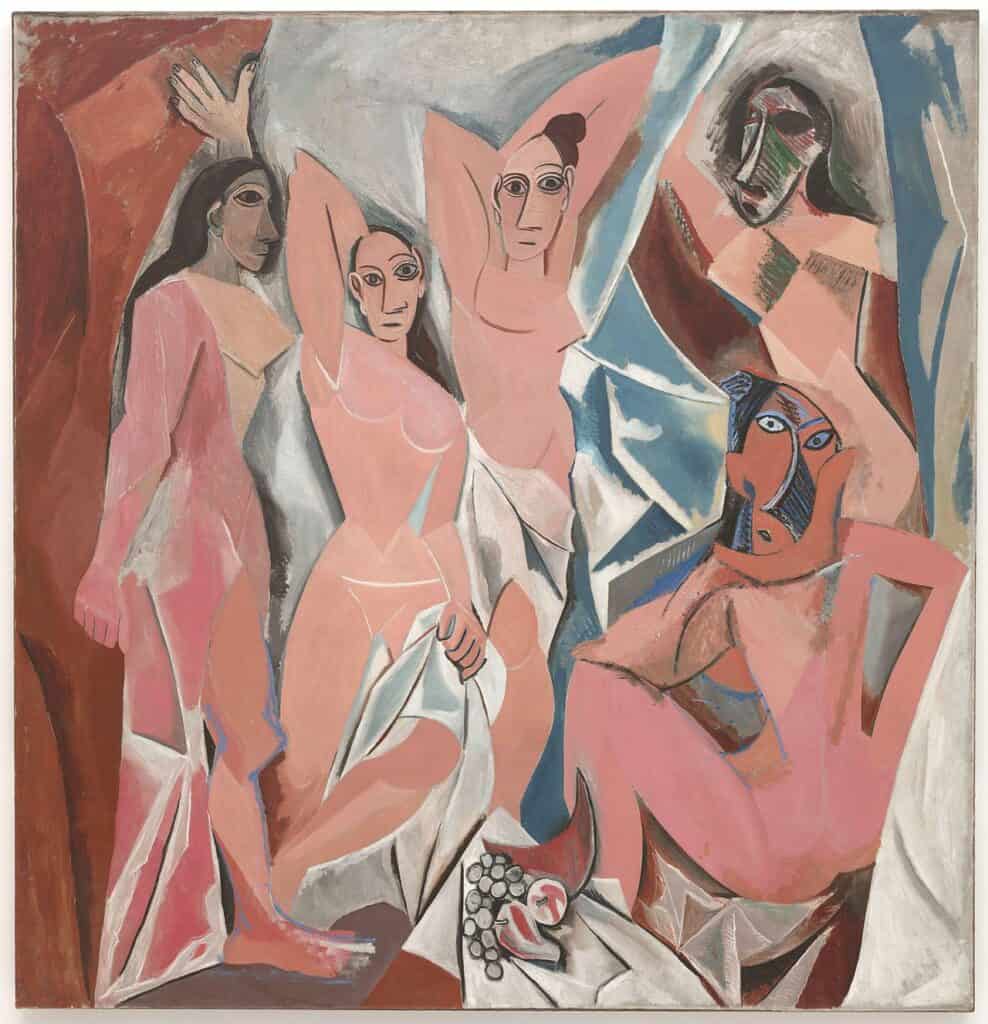Les Demoiselles D'avignon Picasso Analyse
Articles & Features
Stories of Iconic Artworks: Pablo Picasso's Les Demoiselles d'Avignon

By Shira Wolfe
"Others have seen what is and asked why. I have seen what could be and asked why non."
Pablo Picasso
Les Demoiselles d'Avignon (1907) by Pablo Picasso is considered one of those pivotal artistic moments unquestionably dividing the by from the futurity. Modernism was swooping across Europe in the period that Picasso painted this masterpiece, and with it, he reinvented the cycle of Western painting. The artwork depicts five naked women, created from flat, jagged planes, their faces inspired by Iberian sculpture and African masks. Les Demoiselles d'Avignon, Picasso's landmark piece of work, was a forerunner to the manner that became known as Cubism and is frequently considered the commencement Cubist painting. We examine the story and circumstances surrounding the creation of this iconic artwork.
Historical context of Les Demoiselles d'Avignon
Picasso started on his advanced masterpiece in the winter of 1906-1907; he was 25 years old at the fourth dimension. At the start of a new century, in the years leading up to World War I, Picasso seemed to have concluded his Blueish period and have poured his desire to completely reinvent Western art into this one sail. Meanwhile, all throughout the art earth, artists were exploring freely, radically breaking with by traditions, and moving frontwards towards Modernism – Schoenberg equanimous his Erwartung in 1909, Stravinsky created The Rite of Bound in 1910, and with Les Demoiselles d'Avignon signaling the start of Cubism, Picasso was on his very own quest of radically reinventing painting. By the time Picasso was at the stop of his Cubist explorations, it was 1914: James Joyce had started writing Ulysses, and the Kickoff World State of war had just begun.
"It is a work which to my mind transcends painting; information technology is the theater of everything that has happened in the last 50 years."
André Breton


Creating Les Demoiselles d'Avignon
Les Demoiselles d'Avignon was revolutionary considering Picasso absolutely contradicted everything that had been understood every bit correct in Western painting upwardly until that point: he smashed idealized notions of dazzler, did away with conventions of perspective, and worked with styles inspired by Iberian and African art.
Assay
Picasso drew the first designs for Les Demoiselles d'Avignon in the winter of 1906-1907. He produced more preparatory drawings and paintings for this projection than ever before, hundreds of sketches and studies. Information technology wasn't till the early summertime of 1907, well-nigh one-half a year afterward, that he started painting his large canvas. The title of the painting refers to a street in Barcelona, Carrer d'Avinyó, which was known for its many brothels. The five figures, "The Women of Avignon", depict prostitutes of this red-light district in Barcelona boldly staring back at the viewer from the painting. Picasso painted each of the figures quite differently: the faces of the ii figures on the right are equanimous of sharp geometric shapes and are the about Cubist of the figures; the faces of the other 3 figures are painted in the Iberian style.
Picasso had long best-selling the influence of Iberian sculpture on his art, and in 1907, he visited the Musée d'Ethnographie du Trocadéro in Paris, the outset anthropological museum in the metropolis. Hither, he experienced somewhat of an epiphany while viewing the collection of African and Oceanic art and artifacts, in particular the tribal masks. These artworks had an immense impact on Picasso, inspiring the anti-naturalism and the defying of mimetic norms in Les Demoiselles d'Avignon. Picasso had besides been influenced by Gauguin and his artworks created in Tahiti.
Recognition
When the painting was finished, Picasso unveiled information technology in his studio, and it remained there for quite some time, only known to an intimate circle of friends, artists, dealers, and collectors. Kickoff exhibited in 1916, the painting became truly widely recognized for its importance in the early 1920s following André Breton's publication discussing the work. To many, Les Demoiselles d'Avignon was revolutionary, to many information technology was shocking and obscene, but most people hold it heralded in the new direction of the arts in twentieth century, marking the very starting time of Cubism. Picasso's dealer, Daniel-Henry Kahnweiler, wrote about the painting:
"Early in 1907, Picasso began a strange large painting depicting women, fruit, and drapery, which he left unfinished. Information technology cannot be called other than unfinished, fifty-fifty though it represents a long period of piece of work. Begun in the spirit of the works of 1906, information technology contains in one section the endeavors of 1907 and thus never constitutes a unified whole. The nudes, with large, tranquility eyes, stand up rigid, like mannequins. Their stiff, round bodies are mankind-colored, black and white. That is the style of 1906. In the foreground, however, alien to the fashion of the residual of the painting, announced a crouching figure and a bowl of fruit. These forms are drawn angularly, not roundly modeled in chiaroscuro. The colors are luscious blue, strident yellow, next to pure black and white. This is the beginning of Cubism, the first upsurge, a desperate titanic disharmonism with all of the problems at one time."

Where to detect Les Demoiselles d'Avignon
Picasso's Les Demoiselles d'Avignon is on permanent display at the Museum of Modern Fine art in New York. It was offset purchased from Picasso by Jacques Doucet in 1924 for a sum of 25,000 francs. Information technology is thought that Picasso sold the painting at this relatively low cost considering he thought Doucet would stipulate that the painting should go to the Louvre after his expiry. However, this never happened, and when Doucet died in 1929, Les Demoiselles d'Avignon was sold through individual dealers. In 1937, the painting was included in an exhibition at Jacques Seligmann and Co. in New York. Alfred H. Barr Jr. then director of MoMA in New York Urban center insisted on purchasing the painting for the museum, and information technology went on view in that location in 1939. Today, the painting is however on permanent display at the Museum of Modern Art and remains i of the most historic pieces in the museum's art collection.
Relevant sources to learn more
For other articles from the 'Stories of Iconic Artworks' Series, see:
Stories of Iconic Artworks: Picasso's Guernica
Stories of Iconic Artworks: The Marina Abramovic Operation The Firm With The Ocean View
Stories of Iconic Artworks: Dorothea Lange'south Migrant Mother
Stories of Iconic Artworks: Kazimir Malevich'due south Black Square
Stories of Iconic Artworks: Diego Rivera's Rockefeller Mural
Stories of Iconic Artworks: Andy Warhol'due south Oxidation Paintings
Read more about Les Demoiselles d'Avignon
The Guardian: Pablo's Punks
Explore stunning works by Pablo Picasso available for purchase on Artland
Buy artworks by Picasso
Wondering where to offset?



Les Demoiselles D'avignon Picasso Analyse,
Source: https://magazine.artland.com/les-demoiselles-davignon-analysis-picasso-painting/
Posted by: rodriguezwrearpon76.blogspot.com


0 Response to "Les Demoiselles D'avignon Picasso Analyse"
Post a Comment